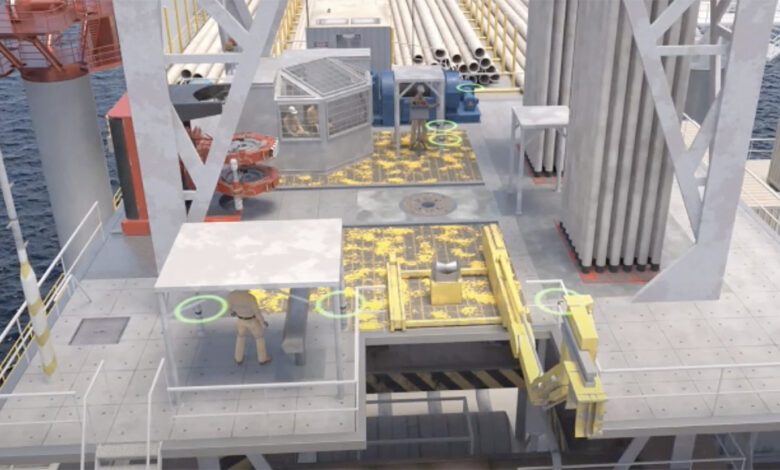Mitigating drops risks through pipe screen replacements, red zone management technology

By Stephen Whitfield, Associate Editor
Dropped objects have continued to pose a significant safety hazard on drilling rigs over the years. At a DROPS (Dropped Objects Prevention Scheme) meeting on 2 November, industry stakeholders came together to look at two sides of the effort to mitigate potential dropped object risks: removing the dropped object from the rig, and keeping people on the rig away from the dropped object.
The meeting featured discussion on the development of a digital system designed to set up “exclusion zones,” or areas of the rig where personnel are not allowed to enter at a given time. It also looked at as the efforts a drilling contractor took in eliminating the risk from a specific dropped object on its rigs.
On the drilling contractor side, Ryan D’Aunoy, Senior Manager of HSE Management Systems at Precision Drilling, spoke about various lessons the company learned from its near-misses with one particular dropped object, overhead drill pipe screens.
Pipe screens are designed to prevent solids from being pumped downhole while drilling, improving the viscosity of the drilling fluid by filtering out solids. They also prevent blockage of the ports in downhole tools.
Precision utilized two types of overhead pipe screens: Downhole filter screens, which can be placed anywhere in the drill string but are typically installed directly above critical equipment, such as the bottomhole assembly, as well as surface drill pipe screens, which are positioned in the top stand of the drill pipe and never go below the rig floor.
Mr D’Aunoy pointed out that both pipe screen types require removal and cleaning after each stand, and crew members have to handle them while they’re positioned above the rig floor because there is no way to securely move them into the derrick. This need for manual handling of overhead equipment can introduce potential risk for injury or even fatality.
Precision saw four dropped pipe screens in its operations in 2022. Two incidents occurred because the saver sub threads stripped, causing the stand to fall into the pipe elevators. Two other incidents occurred because the drill pipe was rotated out at the top drive and, as the stand was moved to be stabbed into the mousehole, the grabber boxes could not hold the weight of the drill pipe. The stand broke free and dropped from the grabber box into the drill pipe elevators.
In all four cases, the pipe screens were ejected from the pipe and fell approximately 90 ft to the rig floor. There were no serious injuries or fatalities in either incident. However, the Dropped Objects consequence calculator showed that, if a crew member had been struck by the pipe screen, the incident could have resulted in a fatality.
“If a pipe screen was to strike somebody on the rig, you’re definitely looking at a serious injury or fatality potential given the weight of the pipe screen and the heights that they’re falling from,” Mr D’Aunoy said. “As we investigated these incidents, we needed to look at our hierarchy of controls to see what we could do about these screens, maybe see if we could just completely take them out of the equation.”
In its investigation of the incidents, Precision discovered that some of its operator clients had begun running inline pipe screens, which are installed in the drilling fluid piping system on the rig floor, instead of above the rig floor. Instead of cleaning these screens after each stand, crew members clean them prior to running casing, and since they aren’t installed above the rig floor, the dropped object risk is eliminated. Precision then decided it would stop using overhead pipe screens.
Precision began replacing its overhead drill pipe screens with inline screens in June, with replacements completed for the majority of its rigs by November. While inline screens could be a viable alternative for drilling contractors industrywide, Mr D’Aunoy acknowledged that cost may be a prohibitive barrier for some companies.
“You haven’t seen much about these pipe screens being dropped, except around where employees were handling them overhead or placing them into the pipe, because there are no means to secure them,” he said. “Each company has to look at the risk/benefit analysis prior to using these pipe screens overhead. With us at Precision, we’ve gotten to the point where we’re just not going to do it anymore because of the risk.”
Keeping people out of harm’s way in red zones
During the DROPS meeting, FSC Systems presented its zone management technology, which combines radio-frequency identification (RFID) with infrared technology to provide instantaneous feedback to drillers on personnel movements around hazardous equipment through electronic barriers.
The system monitors the presence of human activity in pre-determined exclusion zones. Infrared sensors are installed throughout the rig and can be combined to create boundaries for the exclusion zones, each of which contains its own unique ID. It does not utilize wearable technology – instead, the sensors are wired directly to a control panel, and when personnel enter an exclusion zone, it provides instantaneous feedback through an audible alarm. The driller can then stop work in the exclusion zone before a potential incident may occur.
The lack of a wearable sensor element means that the zone management system cannot determine exactly who entered a zone, but Brennan Flores, Petroleum Engineer at FSC, said that this system can provide a more cost-efficient alternative compared with wearable systems, making it easier to justify economically. Further, “with the direct connections to the panel, there’s none of the noise or interference between wireless units that we’ve experienced with the wearables,” he said.
The zone management system was not designed exclusively for dropped objects, but it can be used to keep people out of harm’s way during activities where dropped object risk may be higher than normal. However, this requires drillers to have a solid understanding of the dropped object risks on the rig.
“If a driller knows they’re moving into pipe tripping operations or whatever it may be, he knows he’s got two or three guys that may need to be out there, and other than that no one else needs to be on the drill floor,” Mr Flores said. “He can set an active exclusion zone, and if anybody goes in and out who shouldn’t be there, we’ll catch it. And then when we do need to turn the zone off, he can just disconnect it.”
The zone management technology is effectively meant to help influence behaviors, Mr Flores said. Users can monitor exclusion zone entries with a number of parameters to better identify gaps in procedures. Each barrier break is then logged with a date and time stamp, as well as the exact location. Reports can be generated from this data so that patterns and trends can be drawn for future improvement.
“It we catch a particular area of trouble during a specific operation, you can look at your procedures and see if you have some room for improvement,” he said. “Can we change the way this area is laid out? Can we change something during this operation to avoid having these continual barrier breaks? The patterns and trends you see from this can help with that.” DC





